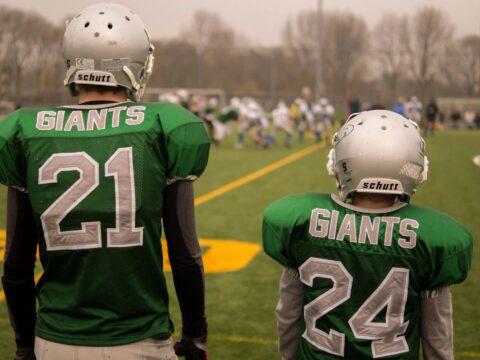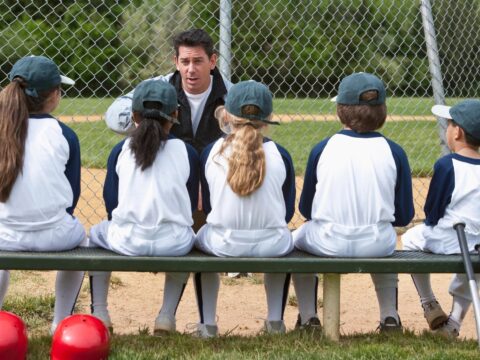Sports are an important consideration for kids, but where can you find the right information and what should you know about investing in and planning for a future in sports for your children?
As a parent, I often catch myself pondering the litany of possibilities for the futures of my children.
Will they pursue a career in art or science?
Will they join the chess club? Or will it be a youth sports team?
It isn’t uncommon to be drawn to thoughts of worry where your children are concerned. We all want what is best for them, and so in an effort to assuage these fears, it is right and proper to give due thought and consideration to their interests as they grow and develop.
“Why should I bother investing in sports for my children? And what should I be wary of while doing so?”
That is an excellent question – thank you for asking! Sports are by no means the only hobby, passion, or interest your child is likely to develop; however, it is by a solid margin one of the most popular for many reasons. There are many notable benefits for children and youths who engage in competitive activities regularly. On top of the various physical and mental benefits of promoting physical activity, teamwork, and a sense of determination in young children, it is also a source of joy and pride for a parent to watch their child compete and succeed while doing something they enjoy.
But you must be wary of taking this too far. Studies have shown that when handled poorly, extracurriculars such as sports can be unduly taxing on youths and parents. In fact, approximately 70 percent of children quit sports altogether by the age of thirteen1 for a variety of reasons, including mounting pressure from the demands of the sport, parental influence, and the difficulty of balancing academic work, practice, and a developing social life.
Second, but by no means less important, is safety. Even before COVID-19 decided to interrupt not only the world of sports but also every other facet of life that Americans consider sacred or entertaining, sports at any level have been rife with injury, whether potential or realized. It is paramount to pursue athletic interests in the safest manner possible.
Below are two links; the first is from the Children’s Hospital of Philadelphia (CHOP) regarding preventative measures to protect against COVID-19 during youth sporting events, and the second is from the CDC on the topic of general safety. While many things listed may seem to be common sense (not so common among many children and teens), it never hurts to be prepared in order to protect one’s children, oftentimes from their own overzealousness.
The Bright Side
Now that I have sufficiently soured your mood with images of burnt-out teens and sports-related injuries, please remember that if approached properly, all such things can be completely avoided. Youth sports can be an amazing opportunity for kids interested and committed to the idea and is again an excellent source of physical and social activity that many children are sorely in need of at present (looking at you COVID).
“Yeah, all that is nice, but not exactly motivational. Besides, where would I even start?”
Another impressive question! If you’ve slogged through to this point, don’t quit. The nice thing about youth sports is that getting started is often the simplest part, at least at the basic levels. Most local school districts have sports programs for a wide swath of age ranges and provide their students with very basic equipment during their practices.
The difficulty comes when extending beyond that bubble. Many communities organize their own leagues for varying ages, competing against other communities regularly. You shouldn’t have much difficulty finding teams for more popular and conventional sports, such as football, soccer, baseball, and track. Again, you will probably have the easiest time reaching out to the school that your child attends. Remember that being proactive and showing interest is a good way to attract attention for yourself and your child.
But if you are looking for an official organization, there are a few that function at the national level, and very well might have a chapter near you.
More than just a collection of acronyms, these organizations manage millions of members and thousands of teams across the country, so finding a place for your son or daughter shouldn’t be much issue. These organizations (and many local ones) often charge membership fees and often require that you purchase your child’s equipment.
“Okay, I get it. But you still haven’t told me what sport(s) I should invest in for my child.”
How rude of me! But there are a lot of potential choices. Ideally, the best sport to invest time and money is the one in which your child shows the most interest. Your wallet may disagree.
If the league or team your child is to join requires you to purchase the equipment needed to participate, you could be looking at wide discrepancies in cost. Below is a list of the most common sports, arranged from least to most expensive (roughly). Under each entry, I will list a single online retailer that supplies the equipment needed, but please feel free to shop around for better deals.
Track
Have a good pair of sneakers? Comfortable clothes? A sweatband or three? If so, you’re relatively set for track on a basic level, given that most items will already be part of your child’s wardrobe. Obviously, if you wanted to invest in some expensive track shoes, the price can run quite high, but this isn’t immediately necessary. Obviously, things can become much more complicated as the skill spectrum widens, given that jumping and hurdling can also fall under this category.
Soccer/Rugby
Coming in second, soccer and rugby can be very inexpensive for beginners. If you feel the need to invest in a pair of expensive cleats or a setup for practicing at home, the bills might start to add up over time. Also, these two sports utilize much of the same equipment, convenient for children with dual interests.
Basketball
Basketball is quite simple, requiring sturdy footwear and simple clothing. In this case, even investing in equipment for at-home use won’t be a deal-breaker, as finding an affordable hoop shouldn’t be too much trouble.
Baseball/Softball
Like basketball, baseball and softball are relatively inexpensive when starting out. Uniforms must generally be purchased, however, bats and balls will sometimes be lent for use at games. Even if not, the cost for the basics is quite affordable. This is one sport where the costs can skyrocket as the player begins to take things more seriously – but that’s for another article.
- Baseball/Softball – com
Football, Lacrosse, and Hockey
Though putting these three sports in the same category might enrage some, please hear me out. Football, lacrosse, and hockey all share the common thread of requiring a full body’s worth of equipment and then some. These popular sports do require a significantly higher up-front monetary investment than the previously mentioned activities. Concerning these options, I highly recommend looking to purchase quality used equipment if you find yourself rather daunted by the price but are still set on spending.
- Football – Dick’s Sporting Goods
- Lacrosse – Lacrosse Unlimited
- Hockey – Pure Hockey
Now that the common options are out of the way, I would like to highlight some activities that some might not consider to be ‘conventional’ youth sports. Again, these will be listed from least to most expensive, accompanied by a single online retailer.
Bowling
It’s not the best-known youth sport, but there are thousands of leagues across the country looking for talented youth and adult players of the sport. The nice thing is that generally, you don’t need to purchase any of your own equipment, as your local bowling alley will often provide it once you cover lane and shoe rental. Of course, those truly invested in bowling will often have their own ball and shoes for personal use.
Martial Arts
Martial arts from a good instructor can be an excellent investment in your child’s future; however, it can be rather costly in the long term. The initial price for the uniform required usually isn’t too bad, but the fees from various studios can be demanding. I recommend that you shop around in your area to find the best balance between quality and price.
Dancing
The costs associated with dancing come from both equipment and lessons. Furthermore, the activity can be extremely stressful on young children who aren’t prepared for how demanding it can be. While an excellent investment, be prepared that it is indeed a hefty one. Just like with football, lacrosse, and hockey, it might be prudent to shop for secondhand clothing and other equipment if necessary.
Golf
Golf is another sport that requires a significant upfront cost when starting out unless your local course allows for club rental. In either case, the cost of either renting or buying clubs, along with paying the fee associated with using a course can add up rather quickly.
I hope that you have found this article helpful in understanding the basics and importance of youth sports, as well as the considerations for planning for a future in sports and the potential dangers and pitfalls in investing in something that your child could potentially lose interest in over time. Remember to find a good balance between sports and the remainder of their life. After all, there’s very little point if your child isn’t going to enjoy themselves and grow as a person. Good luck and stay safe!
References
- https://www.washingtonpost.com/news/parenting/wp/2016/06/01/why-70-percent-of-kids-quit-sports-by-age-13/





